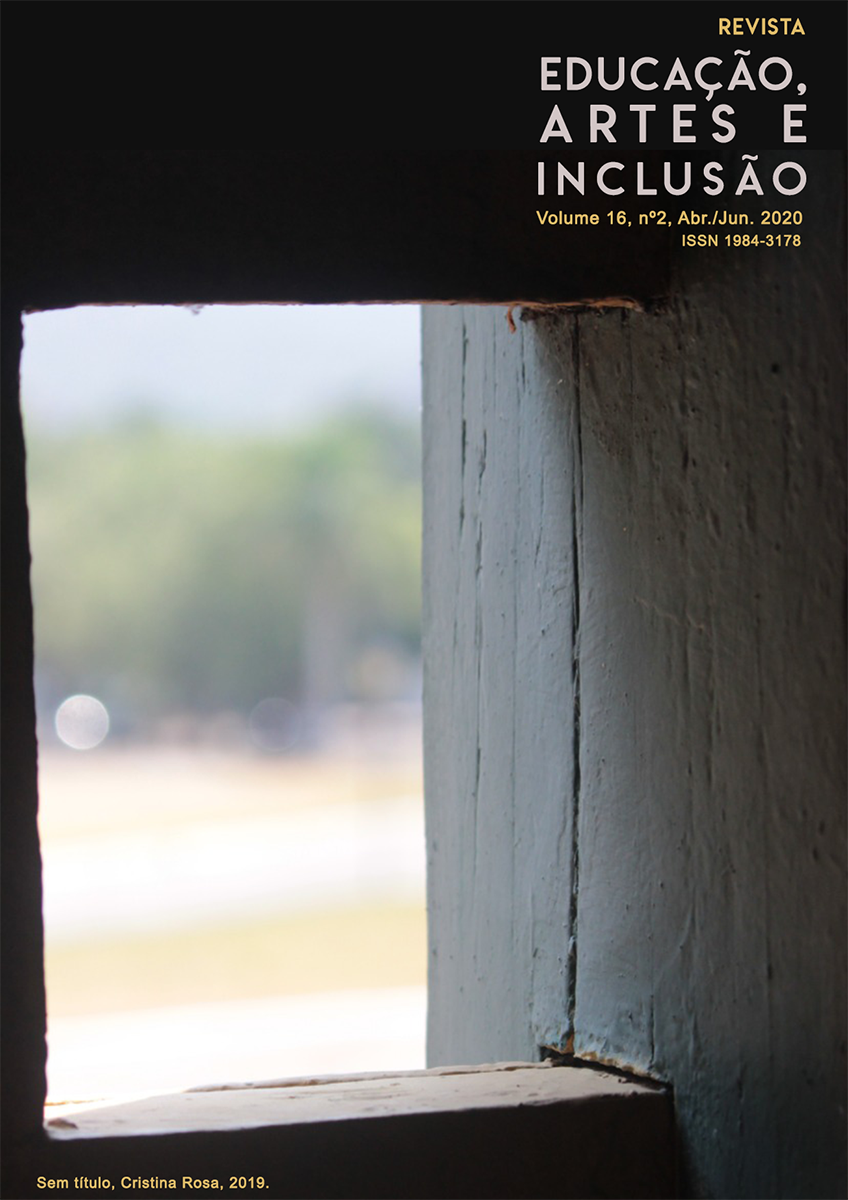Drawing at Visual Art’s teachers education: reflections from Designare
DOI:
https://doi.org/10.5965/1984317815022019007Palavras-chave:
artes visuais, desenho, educação artísticaResumo
This work aims to present some reflections of my PHD research, with the title Designare: pontes artistico/educativas na formação docente em Artes Visuais. This research sought to build an interpretation about the Drawing and its teaching in the Visual Arts teachers education, questioning the "how to draw" and the "not knowing how to draw" in the view of the teachers who teach in this area at the university. At the methodological process, based the investigative ways in three research methodologies of Educational Research Based on Visual Arts (Viadel, 2005): Narrative, Autoetnography and A/r/tography and with research in specialized literature, problematization and justification in narrative memory and interviews making with professors who teach Drawing in graduation courses in the area of Visual Arts at the University of Porto - UPORTO and at the Federal University of the Valley of São Francisco – UNIVASF. Focused on the understanding of the influence of drawing discourses and from drawings as visual narratives on teaching/learning of teachers practices in Visual Arts as rethinking historical issues in curricula, I analyzed issues of pedagogical practices of university professors and their repercussions on contemporary Visual Arts Teachers Education in Brazil and Portugal.
Downloads
Referências
BARROS, M. de. O guardador de águas. Rio de Janeiro: Record, 1998.
BAUER, M. & JOVCHELOVIT, S. Entrevista Narrativa. In: BAUER, M.; GASKELL, G. Pesquisa qualitativa com texto, imagem e som. Petrópolis: Vozes. pgs. 90-113, 2002.
BALDINUCCI, F. Vocabulario Toscano dell ́Arte del Disegno. Accademici dela Crusca. Florença, Itália, 1681.
BRUNER, J. The Narrative Construction of Reality. Critical Inquiry, Chicago, v. 18 (1), 1991, pgs. 1-21.
CABAU, P. O dispositivo do desenho: A implementação da prática do desenho no ensino artístico contemporâneo. Leiria: Edições ESAD, 2012.
CHANG, H. Autoethnography as Method. Walnut Creek, CA: Left Coast Press, 2008.
DIDI-HUBERMAN, G. Quando as imagens tocam o real. Pós. Revista do
Programa de Pós-Graduação em Artes da Escola de Belas Artes da UFMG. v.2., nº 4. Belo Horizonte: UFMG, 2012, pgs.204-219.
ELLIS. C. The Etnographic I: The autoethography. New York: Altamira Press, 2004.
GALVÃO, C. Professor: o início da prática profissional. Tese de Doutorado em Educação. Departamento de Educação. Faculdade de Ciências. Universidade de Lisboa. Lisboa, Portugal, 1998.
HALL, S. The work of representation. In Hall, S. (Ed.). Representation: cultural representations and signifying practices. London: Sage, 2003, pgs. 13-64.
HERNÁNDEZ, P. Reseñas sobre el diseño de la enseñanza. In: HERNÁNDEZ, P. (org.). Diseñar y enseñar: teoría y técnicas de la programación y del proyecto docente. Madrid: Narcea,1989, pgs. 5-21.
IRWIN, R L. A/r/tography: a metonymic métissage. In Irwin, R. L.; Cosson, A. de. (eds.). A/r/tography: rendering self through arts-based living inquiry. Vancouver, Canada: Pacific Educational Press. p. 27-38, 2004.
_________. & SPRINGWAY, S. A/r/tography as practice-based research. In: CAHNMANN-TAYLOR, M.; SIEGESMUND, R. (Eds). Arts-Based Research in Education. Foundations for Practice. New York: Routledge. 2008, pgs. 103-124.
KNOWLES, J. G. & COLE, A. L. Handbook of the Arts in Qualitative Research: perspectives, methodologies, examples and issues. Los Angeles: Sage Publications, 2008.
McEWAN, H. & EGAN, K. (comps.). La narrativa en la enseñanza, el aprendizaje y la investigación. Buenos Aires: Amorrortu, 1998.
MOLINA, J. J. G. Máquinas de dibujar: territórios y escenarios del dibujo. In: MOLINA, J. J. G. (coord.). Máquinas y herramientas de dibujo. Madrid: Cátedra, 2002, pgs. 15-81.
PARDIÑAS, M. J. A. El vuelo de la mariposa: la investigación artístico-narrativa como herramienta de formación. In: VIADEL, R. M. (ed.). Investigación en Educación Artística: temas, métodos y técnicas de indagación sobre el aprendizaje de las artes y culturas visuales. Granada: Editorial Universidad de Granada, 2005.
PEREIRA, M. V. Estética da professoralidade: um estudo crítico sobre a formação do professor. Santa Maria, RS: Editora da UFSM, 2013.
PETHERBRIDGE, D. On models and Mickey Mouse. International Journal of Art and design Education. 24 (2), 2005. pgs.126-135.
_______________.The primacy of drawing. Histories and theories of practice. New Haven and London: Yale University Press, 2011.
REED-DANAHAY, D. (Ed.). Auto/Ethnography: rewriting the self and the social. Oxford: Berg, 1997.
SALLES, C. A. Gesto inacabado: processo de criação artística. São Paulo: FAPESP, Annablume, 1998.
SPRY, T. Performing autoethonography: an embodied methodological praxis. Qualitative Inquiry, 7, 2001.pgs. 706-732
VIADEL, R. M. ‘La Investigación Educativa Basada en las Artes Visuales’ o ‘ArteInvestigación Educativa’. In VIADEL, R. M. (ed.). Investigación en Educación
Downloads
Publicado
Como Citar
Edição
Seção
Licença
Copyright (c) 2020 Flávia Pedrosa Vasconcelos

Este trabalho está licenciado sob uma licença Creative Commons Attribution-NonCommercial 4.0 International License.
A Revista Educação Artes e Inclusão é um periódico que segue a Política de Acesso Livre. Os artigos publicados pela revista são de uso gratuito, destinados a aplicações educacionais e não comerciais. Os artigos cujos autores são identificados representam a expressão do ponto de vista de seus autores e não a posição oficial da Revista Educação, Artes e Inclusão [REAI].
Autores que publicam nesta revista concordam com os seguintes termos:
(a) Autores mantém os direitos autorais e concedem à revista o direito de primeira publicação, com o trabalho simultaneamente licenciado sob a Licença Creative Commons Attribution que permite o compartilhamento do trabalho com reconhecimento da autoria e publicação inicial nesta revista.
(b) Autores têm autorização para assumir contratos adicionais separadamente, para distribuição não-exclusiva da versão do trabalho publicada nesta revista (ex.: publicar em repositório institucional ou como capítulo de livro), com reconhecimento de autoria e publicação inicial nesta revista.
(c) Esta revista proporciona acesso público a todo o seu conteúdo, uma vez que isso permite uma maior visibilidade e alcance dos artigos e resenhas publicados. Para maiores informações sobre esta abordagem, visite Public Knowledge Project.
Esta revista está licenciada com uma Licença Creative Commons Atribuição-NãoComercial 4.0 Internacional. Esta licença permite que outros remixem, adaptem e criem a partir do seu trabalho para fins não comerciais, e embora os novos trabalhos tenham de lhe atribuir o devido crédito e não possam ser usados para fins comerciais, os usuários não têm de licenciar esses trabalhos derivados sob os mesmos termos.





